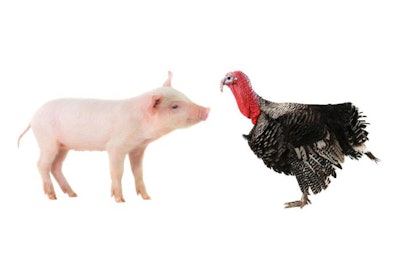
Douglas Tiffany, assistant extension professor at the University of Minnesota, discussed using methods adapted to fight against swine viruses to also help the poultry industry in their battle against avian influenza during the University of Minnesota webinar, "Economics of biosecurity choices" on September 12.
Tiffany has spent ample time looking at choices available to turkey producers tying to enhance biosecurity following highly pathogenic avian influenza (HPAI) outbreaks in Minnesota in 2014.
At the time of the outbreak, researchers hoped to find the direct cause, but no single cause has ever been proven.
Tiffany explained that Minnesota’s turkey producers first response to avian influenza was to implement cost-effective practices and behaviors of their workers. Wash pads and Danish entries have been very popular and relatively inexpensive. Tiffany estimates that is a cost of $0.29 per bird sold to use a wash pad and $0.18 capital cost per bird sold to utilize a Danish entry. “This isn’t too bad when you’re counting pennies on the things you are doing,” he said.
He also emphasized that it takes time and space to make sure that biosecurity is done right.
When studying the economics of biosecurity, Tiffany explained that it was important to learn the costs of production of turkey from older, conventional and advanced designs. It is also important to understand whether poultry producers have the ability financially to replace aging facilities, add capital cost and add operational treatments to control avian influenza and other diseases while still maintaining return on investment, he explained.
A look at the swine industry
The pork industry has found success in utilizing air filtration systems to gain control of the Porcine Reproductive and Respiratory Syndrome virus (PRSS) while still receiving an economic return.
“There are a number of companies that make some very elegant filters,” he said. He referred to the European company Camfil Farr when explaining the use of filters. These filters that are capable of capturing viruses are often set up in combination of MERV 8 and MERV 14.
MERV stands for Minimum Efficiency Rating Value. This is an industry standard rating system that allows consumers to compare filters made by different manufacturers. A MERV rating is a numerical value ranging from 1 which is the lowest efficiency to 20 which is the highest efficiency.
MERV 8 filters are the cheapest and should be replaced every six months depending on the circumstances of a producer's building. MERV 14 filters capture the viruses as they are equipped to catch smaller particles and viruses. However, they are much more expensive and need to be replaced more often.
“As you get to a tighter air filter, it takes more horse power to push a volume of air through it,” he said.
Tiffany explained that there is some evidence that would indicate that, with respect to HPAI, that it is more attached to larger particles, so it might be possible to get by with a cheaper filter. “One that doesn’t limit the air as much, but there is need for testing and proving this,” he said.
A direct cost or life span for the filters can not be given at this time for a poultry house because different dust levels from litter may impact their use.
In swine barns, the capital cost of the ventilation system for both brooder and grower barns equals nearly the capital cost of the grower barn, which is US$450,000. Tiffany explained though that some studies have shown that in swine operations where this system has been used, they have seen enough improvement in health and little size to justify the cost.
The initial cost of $450,000 doesn’t account for the fact that not all poultry housing systems are air tight, so to speak. This is an issue that would need to be addressed if one was going to consider implementing an air filtration system in their poultry house.
Tiffany also briefly mentioned that some swine scientists are doing research to see if they can release viruses and then catch them again to see how far they travel and how they spread to the stock. He thought that this may eventually have some potential in the poultry industry.
Questions to consider
Tiffany posed several questions during his presentation regarding avian influenza's impact on the poultry industry.
- Will future outbreaks of avian influenza, especially HPAI, result in more dramatic efforts from the turkey industry to protect flocks against the virus?
- Assuming the industry does utilize other tools to protect against the virus, how will higher cost of production affect competitiveness of turkey with other meats?

















